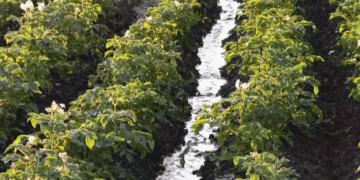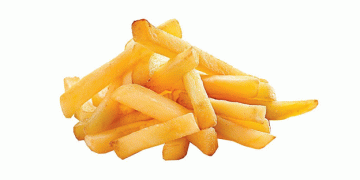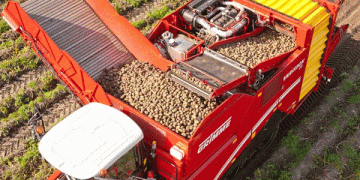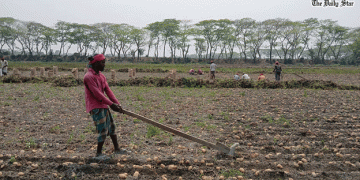While irrigation is key to high potato yields, agronomists are warning that excessive watering—especially early in the growth cycle—can do more harm than good. Understanding when and how to irrigate properly can make the difference between a thriving crop and a stunted, uneven yield.
The Myth of Early Abundant Watering
It’s a common belief among growers that potatoes should be heavily watered after sprouting. However, agronomic research and field experience show that early excessive irrigation may significantly reduce yields. According to experts, watering too soon encourages the formation of shallow root systems, which places the tuber zone near the soil surface. In turn, this increases the risk of overheating and moisture stress, particularly during summer heatwaves.
Potatoes, unlike tomatoes or peppers, have a high water demand, comparable only to crops like cucumbers. The transpiration coefficient—which measures how much water is required to produce 1 gram of dry matter—is around:
- 90–120 for tomatoes
- 80–236 for potatoes
- 250–360 for cucumbers
This means potatoes are indeed water-intensive, but timing and moderation are critical.
The Dangers of Early Irrigation
Early, abundant watering (right after emergence) may delay tuber formation and push root development to the topsoil layer, making roots more vulnerable to:
- Overheating in high temperatures
- Rapid drying of the upper soil layer
- Stunted or uneven tuber growth
The result? Instead of a uniform crop, growers may end up with a few large tubers and many small ones, or worse—tiny tubers the size of peas.
When and How to Water Properly
Agronomists recommend delaying the first irrigation until potato tops reach 10–15 cm. At this stage, the plants begin active vegetative growth, and the need for external moisture increases.
Irrigation Guidelines:
- Frequency: Every 5–7 days or less, depending on soil type and weather conditions
- Intensity: Moderate but sufficient, avoid flooding
- Goal: Maintain steady soil moisture without prolonged drying or saturation
The critical phase for irrigation is late budding through full flowering, when stolon formation and tuber bulking are at their peak. Water stress during this period can cut yields by 30% or more, which is difficult to recover later in the season.
Scientific Backing
A study published in Agricultural Water Management (2022) confirms that irrigation during tuber initiation and bulking stages has the greatest positive impact on potato yield and quality. Early-stage overwatering showed no significant yield benefits and sometimes led to disease pressure and poor root development.
Potatoes are water-loving crops—but water at the wrong time can do more damage than drought. Early restraint followed by well-timed, moderate irrigation during key growth stages will help you avoid shallow roots, irregular tubers, and massive yield losses. Mastering irrigation timing is one of the most powerful tools in every potato grower’s toolkit.






